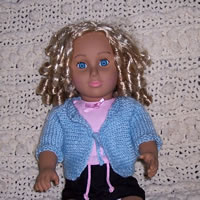
Yarn: Caron Simply Soft Baby Sport
Model: Colocha

Yarn: Cascade Quatro
Model: Lucia
Mirror Sweater
Hand Knit, Drop Sleeve Sweater Pattern.This page has a generator to create a pattern for a simple hand knit sweater. It's a fairly easy generator to use, and a very easy pattern. The design is similar to my mirror vest, but I've added sleeves, made the armholes tighter, and made the front panels overlap just a tiny bit.
The pattern is set to load with the default measurements for size 6; these match my sweater (except for the simplifications that result from making a drop sleeve.) I programmed sizes between 4 and 22 and the dolls size into a pull down menu; it also also has a "custom" feature to permit you to modify the default choices for these sizes. (My arms are short, I always shorten the sleeves. )
Features of this pattern:
- Cast on at center front, knit body sideways.
- Drop shoulder sleeves knit circular. (Easy, little shaping.)
- Default
has full length sleeves; Colocha, my doll is modeling 3/4 length ones
because I got tired of knitting long sleeves for a stupid doll
sweater!
- Body knit back and forth; sleeves knit in the round.
- Stockinette body and sleeve.
- Garter stitch trim; decreasing across row prevents it from spreading.
- Front closed with little crochet ties or a pin. (You could knit I-Cord ties to close.)
- Neck folds back.
- Generator
asks gauge before and
after washing and blocking swatch. This is useful
if you use a yarn that shrinks, or if you decide to felt the
garment. If
you are knitting with a yarn that didn't shrink when you treated it,
just pick "same" and enter the gauge you measured after treating the
swatch.
- Pattern generator has a pull down menu for a range of dress sizes, but you can also customize to the measurements you like.
Lucia Liljegren
PS. If you are shopping for good prices on knitting machines or parts, a sewing machine or any household appliance, AllBrands.com has them. Their prices and service are excellent.
|
My site is supported by your annual $3 donation. Please click. |
|